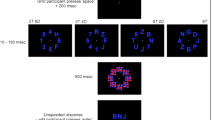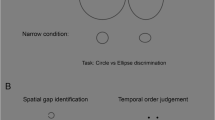Summary
Studies of attention have generally assumed that the principal limit to visual perception involves the capacity to identify a stimulus. Analyses of responses in visual tasks, however, suggest that errors can arise from a loss of position information, as well as a loss of identity information, and that these two types of errors may be affected by different variables. Based on this, we have proposed that the difficult aspect of perception is not that of recognizing the form of the stimulus but rather determining its position relative to other items in the field. To demonstrate this, we conducted a series of experiments on lateral masking that showed that the failure to perceive a parafoveal stimulus surrounded by other items is due to two quite separate components: a loss of identity information induced by the immediately adjacent items and a loss of position information induced by both adjacent and non-adjacent items.
Similar content being viewed by others
References
Attneave, F. (1959). Applications of information theory to psychology. New York: Holt.
Bouma, H. (1970). Interaction effects in parafoveal letter recognition. Nature, 226, 177–178.
Breitmeyer, B. G., Klopfl, W., & Julesz, B. (1982). The existence and role of retinotopic and spatiotopic forms of visual persistence. Acta Psychologica, 52, 175–196.
Broadbent, D. (1958). Perception and communication. New York: Pergamon Press.
Butler, B. E. (1974). The limits of selective attention in tachistoscopic recognition. Canadian Journal of Psychology, 28, 199–213.
Butler BE (1980a) Selective attention and stimulus localization in visual perception. Canadian Journal of Psychology 34:119–133
Butler BE (1980b) The category effect in visual search: Identification versus localization factors. Canadian Journal of Psychology 34:238–247
Butler, B. E. (1981a). Identification and localization in tachistoscopic recognition: The effects of data- and resource-limitations. Canadian Journal of Psychology, 35, 36–51.
Butler, B. E. (1981b). Canadian studies of visual information processing: 1970–1980. Canadian Psychology, 22, 113–128.
Butler, B. E., & Morrison, I. (1984). Do letter features migrate?: A note of caution. Psychological Research, 46, 223–236.
Campion, J., Latto, R., & Smith, Y. M. (1983). Is blindsight an effect of scattered light, spared cortex, and nearthreshold vision? The Behavioral and Brain Sciences, 6, 423–486.
Coltheart, M. (1980). Iconic memory and visible persistence. Perception & Psychophysics, 27, 183–228.
Estes, W. K. (1975). The locus of inferential and perceptual processes in letter identification. Journal of Experimental Psychology: General, 104, 122–145.
Estes, W. K. (1978). Perceptual processing in letter recognition and reading. In E. C. Carterette & M. P. Friedman (Eds.), Handbook of perception: Vol. IX: Perceptual processing. New York: Academic Press.
Garner, W. R. (1972). The Processing of information and structure. Potomac, MD: Erlbaum.
Haber, R. N. (1983). The impending demise of the icon: A critique of the concept of iconic storage in visual information processing. The Behavioral and Brain Sciences, 6, 1–54.
Heijden, A. H. C. van der (1984). Postcategorical filtering in a bar-probe task. Memory & Cognition, 12, 446–457.
Heijden, A. H. C. van der (1986). On selection in vision. Psychological Research, 48, this issue.
Heijden, A. H. C. van der, Hagenaar, R., & Bloem, W. (1984). Two stages in postcategorical filtering and selection. Memory & Cognition, 12, 458–469.
Marr, D. (1982). Vision. New York: Freeman.
Massaro, D. W., & Klitzke, D. (1979). The role of lateral masking and orthographic structure in letter and word recognition. Acta Psychologica, 43, 413–426.
Mewhort, D. J. K. (1978). DIS: An n-channel tachistoscope algorithm. Behavioral Research Methods & Instrumentation, 10, 756–760.
Mewhort, D. J. K., & Butler, B. E. (1983). On the nature of brief visual storage: there never was an icon. The Behavioral and Brain Sciences, 6, 31–33.
Mewhort, D. J. K., & Campbell, A. J. (1978). Processing spatial information and the selective masking effect. Perception & Psychophysics, 24, 93–101.
Mewhort, D. J. K., & Campbell, A. J. (1981). Toward a model of skilled reading: An analysis of performance in tachistoscopic tasks. In G. E. MacKinnon & T. G. Waller (Eds.), Reading research: Advances in theory and practice: Vol. 3 (pp. 39–118). New York: Academic Press.
Mewhort, D. J. K., & Leppmann, K. P. (1985). Information persistence: Testing spatial and identity information with a voice probe. Psychological Research, 47, 51–58.
Mewhort, D. J. K., Campbell, A. J., Marchetti, F. M., & Campbell, J. I. D. (1981). Identification, localization, and “iconic memory”: An evaluation of the bar-probe task. Memory & Cognition, 9, 50–67.
Mewhort, D. J. K., Marchetti, F. M., Gurnsey, R., & Campbell, A. J. (1984). Information persistence: A dual-buffer model for initial processing. In H. Bouma & D. G. Bouwhuis (Eds.), Attention & Performance: Vol. X: Control of language processes (pp. 287–298). London: Erlbaum.
Mishkin, M., Ungerleider, L. G., & Macko, K. A. (1983). Object vision and spatial vision: Two cortical pathways. Trends in Neuroscience, 6, 414–417.
Navon, D. (1977). Forest before trees: The precedence of global features in visual perception. Cognitive Psychology, 9, 353–383.
Pashler, H. (1984). Evidence against late selection: Stimulus quality effects in previewed displays. Journal of Experimental Psychology: Human Perception and Performance, 10, 429–448.
Townsend, J. T., Taylor, S. G., & Brown, D. R. (1971). Lateral masking for letters with unlimited viewing time. Perception & Psychophysics, 10, 375–378.
Trevarthen, C. (1968). Two mechanisms of vision in primates. Psychologische Forschung, 31, 299–337.
Ungerleider, L. G., & Mishkin, M. (1982). Two cortical visual systems. In D. J. Ingle, M. A. Goodale, & R. J. W. Mansfield (Eds.), Analysis of visual behavior (pp. 549–586). Cambridge, Mass: MIT. Press.
Woodworth, R. W. (1938). Experimental Psychology. New York: Holt.
Yeomans, I. (1985). Stimulus duration and partial report performance. Perception & Psychophysics, 37, 163–169.
Author information
Authors and Affiliations
Additional information
This research was supported by grant A-9581 from the Natural Sciences and Engineering Research Council of Canada to the senior author. The first two experiments were reported in a paper to the annual meeting of the Psychonomics Society, San Antonio, 1984
Rights and permissions
About this article
Cite this article
Butler, B.E., Currie, A. On the nature of perceptual limits in vision. Psychol. Res 48, 201–209 (1986). https://doi.org/10.1007/BF00309084
Issue Date:
DOI: https://doi.org/10.1007/BF00309084




